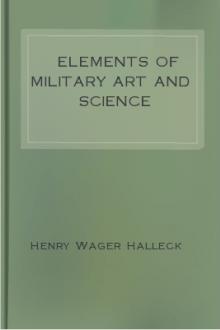Elements of Military Art and Science by Henry Wager Halleck (books you have to read txt) 📕

- Author: Henry Wager Halleck
- Performer: -
Book online «Elements of Military Art and Science by Henry Wager Halleck (books you have to read txt) 📕». Author Henry Wager Halleck
We see that, thus far in these wars, the English were vastly superior in strength and numbers, yet the result of the several campaigns was decidedly in favor of the French, who not only retained their possessions in the North, but extended their jurisdiction to the mouth of the Mississippi, and laid claim to the whole country west of the Alleghany mountains. This success must be attributed, not to any superiority of the Canadians in bravery, but to the higher military character of their governors, and more especially to their fortifications, which were constructed in situations most judiciously selected, to influence the Indians and facilitate incursions into the English colonies. The French pursued interior and central lines, while the English followed exterior and divergent lines. The disparity of numbers was always very great. At the beginning of the eighteenth century, the whole population of the colonies amounted to upwards of one million of souls, while that of both Canada and Louisiana did not exceed fifty-two thousand. But the French possessions, though situated at the extremities of a continent and separated by an almost boundless wilderness, were nevertheless connected by a line of military posts, strong enough to resist the small arms that could then be brought against them. This fort-building propensity of the French became a matter of serious alarm to the colonies, and in 1710 the legislature of New York especially protested against it in an address to the crown. While the military art was stationary in England, France had produced her four great engineers—Errard, Pagan, Vauban, and Cormontaigne; and nowhere has the influence of their system of military defence been more strikingly exhibited than in the security it afforded to the Canadian colony, when assailed by such vastly superior British forces. Still further accessions were now made to these English forces by large reinforcements from the mother country, while the Canadians received little or no assistance from France; nevertheless they prolonged the war till 1760, forcing the English to adopt at last the slow and expensive process of reducing all their fortifications. This will be shown in the following outline of the several campaigns.
Very early in 1755, a considerable body of men was sent from Great Britain to reinforce their troops in this country. These troops were again separated into four distinct armies. The first, consisting of near two thousand men, marched to the attack of Fort Du Quesne, but was met and totally defeated by one-half that number of French and Indians. The second division, of fifteen hundred, proceeded to attack Fort Niagara by way of Oswego, but returned without success. The third, of three thousand seven hundred men, met and defeated Dieskau's army of twelve hundred regulars and six hundred Canadians and Indians, in the open field, but did not attempt to drive him from his works at Ticonderoga and Crown Point. The fourth, consisting of three thousand three hundred men and forty-one vessels, laid waste a portion of Nova Scotia; thus ending the campaign without a single important result. It was commenced under favorable auspices, with ample preparations, and a vast superiority of force; but this superiority was again more than counterbalanced by the faulty plans of the English, and by the fortifications which the French had erected, in such positions as to give them a decided advantage in their military operations. Washington early recommended the same system of defence for the English on the Ohio; and, after Braddock's defeat, advised "the erection of small fortresses at convenient places to deposit provisions in, by which means the country will be eased of an immense expense in the carriage, and it will also be a means of securing a retreat if we should be put to the rout again."
But this advice of Washington was unheeded, and the campaign of 1756 was based upon the same erroneous principles as the preceding one. The first division, of three thousand men, was to operate against Fort Du Quesne; the second, of six thousand men, against Niagara; the third, of ten thousand men, against Crown Point; and a fourth, of two thousand men, was to ascend the Kennebec river, destroy the settlements on the Chaudiere, and, by alarming the country about Quebec, produce a diversion in favor of the third division, which was regarded as the main army, and was directed along the principal line of operations. The entire French forces at this time consisted of only three thousand regulars and a body of Canadian militia. Nevertheless, the English, with forces nearly six times as numerous, closed the campaign without gaining a single advantage.
We here see that the French, with very inferior forces, still continued successful in every campaign, uniformly gaining advantage over their enemy, and gaining ground upon his colonies. By the possession of Forts William Henry, Ticonderoga, and Crown Point, they completely commanded Lake George and Lake Champlain, which afforded the shortest and easiest line of communication between the British colonies and Canada. By means of their forts at Montreal, Frontenac, Detroit, &c., they had entire dominion of the lakes connecting the St. Lawrence with the Mississippi, and Canada with Louisiana; moreover, by means of Fort Du Quesne and a line of auxiliary works, their ascendency over the Indians on the Ohio was well secured. But experience had at length taught the English wherein lay the great strength of their opponents, and a powerful effort was now to be made to displace the French from their fortresses, or at least to counterbalance these works by a vast and overwhelming superiority of troops.
In 1757, a British fleet of fifteen ships of the line, eighteen frigates, and many smaller vessels, and a land force of twelve thousand effective men, were sent to attempt the reduction of the fortifications of Louisburg; but they failed to effect their object.
In 1758 the forces sent against this place consisted of twenty ships of the line and eighteen frigates, with an army of fourteen thousand men. The harbor was defended by only five ships of the line, one fifty-gun ship, and five frigates, three of which were sunk across the mouth of the basin. The fortifications of the town had been much neglected, and in general had fallen into ruins. The garrison consisted of only two thousand five hundred regulars, and six hundred militia. Notwithstanding that the number of guns of the British fleet exceeded both the armaments of the French ships and of all the forts, these British ships did not risk an attack, but merely acted as transports and as a blockading squadron. Even the French naval defence, and the outer works commanding the harbor, were reduced by the temporary land-batteries which Wolfe erected; and the main work, although besieged by an inequality of forces of nearly five to one, held out for two months, and even then surrendered through the fears and petitions of the non-combatant inhabitants, and not because it had received any material injury from the besiegers. The defence, however, had been continued long enough to prevent, for that campaign, any further operations against Canada. The whole number of the English land forces in this campaign was computed at fifty thousand men, of which more than forty thousand were in the field. The first division, of nine thousand men, was directed against Fort Du Quesne, whose garrison did not exceed as many hundred. The second division, of sixteen thousand effective troops, proceeded against Ticonderoga and Crown Point; while a detachment of three thousand men captured Fort Frontenac, then garrisoned by only one hundred and ten men. The whole force of the French amounted to only five thousand; the English attempted to drive them from their works by storm, but were repulsed with a loss of near two thousand men, while their opponents were scarcely injured. The third division acted, as has just been stated, in concert with the naval force against Louisburg.
In 1759, the western division of the English army, consisting of a strong body of Indians, and five thousand troops, wasted the whole season in reducing Fort Niagara, which was garrisoned by only six hundred men. The central column of thirteen thousand men was sufficiently successful to enable it to winter at Crown Point. The eastern division of eight thousand men under Wolfe ascended the St. Lawrence with a fleet of twenty-two ships, thirteen frigates, and fourteen sloops, and smaller vessels, carrying one thousand nine hundred and ninety guns, and five thousand five hundred and ninety seamen. The naval defence of Quebec consisted of eight frigates, carrying two hundred and ten guns; the land forces numbered about nine thousand, and the fortifications were armed with ninety-four guns and five mortars, only a part of which could be brought to bear upon the anchorage ground. Several attempts were made by the combined forces to carry these works, but they proved equally unsuccessful. Although the English fleet carried twenty times as many guns as the forts, their inability to reduce these works was acknowledged. The siege had continued for two months, and still the fortifications were uninjured. General Wolfe himself distinctly stated, that, in any further attempt to carry the place, the "guns of the shipping could not be of much use;" and the chief engineer of the expedition gave it as his opinion, that "the ships would receive great damage from the shot and bombs of the upper batteries, without making the least impression upon them." Under these circumstances it was finally determined to endeavor to decoy Montcalm from his works, and make him risk a battle in the open field. In an evil hour, the French consented to forego the advantages of their fortifications, and the contest was finally decided on the plains of Abraham, with forces nearly equal in number. Both Wolfe and Montcalm fell in this battle, but the former on the field of victory; and five days afterwards the inhabitants of Quebec, weakened and dispirited by their losses, surrendered the town, although its fortifications were still unharmed.
The French, in this campaign, had relinquished all idea of opposing the enemy in the open field, and confined their efforts to retard the advance of the English till France could send troops to their relief; but no such relief came, and when the campaign of 1760 opened, the little





Comments (0)